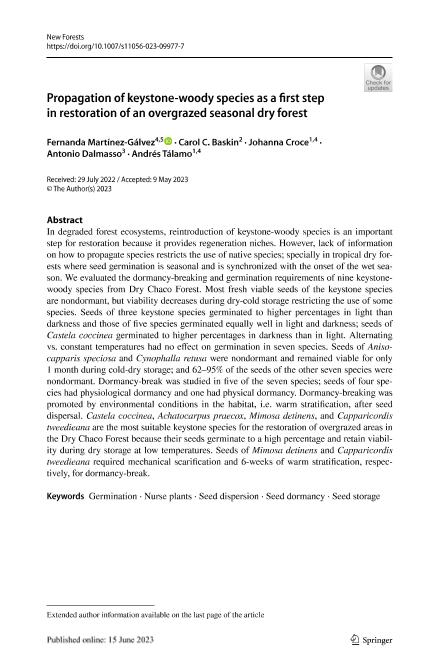Mostrar el registro sencillo del ítem
dc.contributor.author
Martínez Gálvez, María Fernanda

dc.contributor.author
Baskin, Carol C.
dc.contributor.author
Croce, Johanna

dc.contributor.author
Dalmasso, Antonio Daniel

dc.contributor.author
Tálamo, Andrés

dc.date.available
2024-03-13T15:09:42Z
dc.date.issued
2023-06
dc.identifier.citation
Martínez Gálvez, María Fernanda; Baskin, Carol C.; Croce, Johanna; Dalmasso, Antonio Daniel; Tálamo, Andrés; Propagation of keystone-woody species as a first step in restoration of an overgrazed seasonal dry forest; Springer; New Forests; 55; 2; 6-2023; 363-382
dc.identifier.issn
0169-4286
dc.identifier.uri
http://hdl.handle.net/11336/230407
dc.description.abstract
In degraded forest ecosystems, reintroduction of keystone-woody species is an important step for restoration because it provides regeneration niches. However, lack of information on how to propagate species restricts the use of native species; specially in tropical dry forests where seed germination is seasonal and is synchronized with the onset of the wet season. We evaluated the dormancy-breaking and germination requirements of nine keystonewoody species from Dry Chaco Forest. Most fresh viable seeds of the keystone species are nondormant, but viability decreases during dry-cold storage restricting the use of some species. Seeds of three keystone species germinated to higher percentages in light than darkness and those of fve species germinated equally well in light and darkness; seeds of Castela coccinea germinated to higher percentages in darkness than in light. Alternating vs. constant temperatures had no efect on germination in seven species. Seeds of Anisocapparis speciosa and Cynophalla retusa were nondormant and remained viable for only 1 month during cold-dry storage; and 62–95% of the seeds of the other seven species were nondormant. Dormancy-break was studied in fve of the seven species; seeds of four species had physiological dormancy and one had physical dormancy. Dormancy-breaking was promoted by environmental conditions in the habitat, i.e. warm stratifcation, after seed dispersal. Castela coccinea, Achatocarpus praecox, Mimosa detinens, and Capparicordis tweedieana are the most suitable keystone species for the restoration of overgrazed areas in the Dry Chaco Forest because their seeds germinate to a high percentage and retain viability during dry storage at low temperatures. Seeds of Mimosa detinens and Capparicordis tweedieana required mechanical scarifcation and 6-weeks of warm stratifcation, respectively, for dormancy-break.
dc.format
application/pdf
dc.language.iso
eng
dc.publisher
Springer

dc.rights
info:eu-repo/semantics/openAccess
dc.rights.uri
https://creativecommons.org/licenses/by-nc-sa/2.5/ar/
dc.subject
Germination
dc.subject
Nurse plants
dc.subject
Seed dispersion
dc.subject
Seed dormancy
dc.subject.classification
Ecología

dc.subject.classification
Ciencias Biológicas

dc.subject.classification
CIENCIAS NATURALES Y EXACTAS

dc.title
Propagation of keystone-woody species as a first step in restoration of an overgrazed seasonal dry forest
dc.type
info:eu-repo/semantics/article
dc.type
info:ar-repo/semantics/artículo
dc.type
info:eu-repo/semantics/publishedVersion
dc.date.updated
2024-03-12T11:00:38Z
dc.journal.volume
55
dc.journal.number
2
dc.journal.pagination
363-382
dc.journal.pais
Alemania

dc.journal.ciudad
Berlin
dc.description.fil
Fil: Martínez Gálvez, María Fernanda. Consejo Nacional de Investigaciones Científicas y Técnicas. Centro Científico Tecnológico Conicet - Salta. Instituto de Bio y Geociencias del NOA. Universidad Nacional de Salta. Facultad de Ciencias Naturales. Museo de Ciencias Naturales. Instituto de Bio y Geociencias del NOA; Argentina
dc.description.fil
Fil: Baskin, Carol C.. University of Kentucky; Estados Unidos
dc.description.fil
Fil: Croce, Johanna. Consejo Nacional de Investigaciones Científicas y Técnicas. Centro Científico Tecnológico Conicet - Salta. Instituto de Bio y Geociencias del NOA. Universidad Nacional de Salta. Facultad de Ciencias Naturales. Museo de Ciencias Naturales. Instituto de Bio y Geociencias del NOA; Argentina
dc.description.fil
Fil: Dalmasso, Antonio Daniel. Consejo Nacional de Investigaciones Científicas y Técnicas. Centro Científico Tecnológico Conicet - Mendoza. Instituto Argentino de Investigaciones de las Zonas Áridas. Provincia de Mendoza. Instituto Argentino de Investigaciones de las Zonas Áridas. Universidad Nacional de Cuyo. Instituto Argentino de Investigaciones de las Zonas Áridas; Argentina
dc.description.fil
Fil: Tálamo, Andrés. Consejo Nacional de Investigaciones Científicas y Técnicas. Centro Científico Tecnológico Conicet - Salta. Instituto de Bio y Geociencias del NOA. Universidad Nacional de Salta. Facultad de Ciencias Naturales. Museo de Ciencias Naturales. Instituto de Bio y Geociencias del NOA; Argentina
dc.journal.title
New Forests

dc.relation.alternativeid
info:eu-repo/semantics/altIdentifier/url/https://link.springer.com/10.1007/s11056-023-09977-7
dc.relation.alternativeid
info:eu-repo/semantics/altIdentifier/doi/http://dx.doi.org/10.1007/s11056-023-09977-7
Archivos asociados
